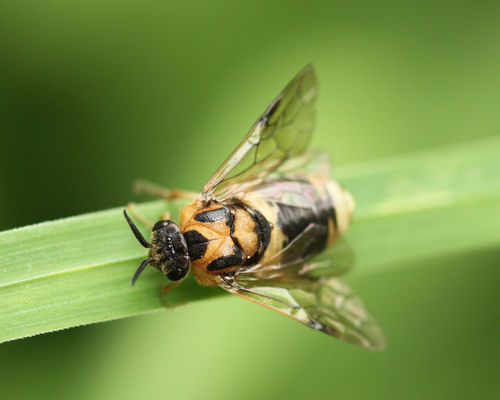Pine sawfly Diprion pini first record for Worcestershire
Harry Green (compiler)
Martin Smith sent by email a picture of a sawfly (01) to Worcestershire Wildlife Trust at the end of August 2013. It had been taken on 26th August 2013 at Deerfold Wood, near Wadborough, a mainly coniferous woodland. The sawfly was found low down on a blade of grass just outside the wood. It appeared to be of Diprion pini (Pine sawfly). There no records in the Worcestershire Biological Records Centre (WBRC) database and few on the NBN Gateway. Internet searches were not helpful but revealed that the species could be a pest that defoliated conifers. To gain further information Geoff Trevis send the picture to sawfly expert Guy Knight, Head of Zoology & Curator of Invertebrates, National Museums Liverpool and I sent it to
Forestry Commission, Forest Research, Alice Holt Lodge, Farnham.
Guy Knight replied “Diprion pini is not a common insect at all and I have only see it occasionally. Even working in Caledonian pine forest over the past few years it was quite difficult to find! It is an adventive species, having years of super-abundance at a site followed by years when it is hard to find. Similarly, it is difficult to predict where it will turn up - this year I was surprised to see thousands of larvae stripping ornamental dwarf pines in a park right in the centre of Liverpool; it will do the same thing in plantations, where it can be a pest”.
Christine Tilbury, Advisory Entomologist at Forest Research replied “We do have a number of records for Diprion pini but none from Worcestershire” and sent scans of two informative documents. First, Forestry Commission Leaflet no. 35 “Pine Sawflies” (1955) and, second, a page entitled Neodiprion sertifer and Diprion pini from Bevan 1987.
Leaflet No. 35 gives a good description of Diprion pini life history as follows:
“Diprion pini. The adult sawflies emerge in May or June from cocoons which have overwintered in the upper soil and litter layers of the forest floor. The females deposit their eggs in slits cut with their saw-like ovipositors in the previous year's pine needles, a number of eggs commonly being laid in a row in any one needle. The cavity containing each egg is roofed over with a foam-like substance extruded by the female which hardens into a cap of honeycomb appearance. The larvae hatch in two to three weeks and commence feeding upon the needles, at first eating only the outer margins, but later devouring the whole needle down to the needle sheath and sometimes even gnawing off the bark of the shoots. During the whole of this period the caterpillars feed together in a compact colony. If disturbed, all the individuals of each colony suddenly rear themselves into an S-shaped posture, which is believed to be a "threatening attitude" designed to discourage their foes. In July they spin cocoons, either attached to the tree on which they have been feeding or in the soil. Sometimes there may be only one generation per year, but more usually these cocoons give rise to another flight of adults in late July or August. The females of this second generation immediately lay eggs, and the resultant larvae feed as did the first generation. Later, usually in September, they spin cocoons in the soil in which they pass the winter before transforming into pupae in the spring.”
Diprion pini can cause considerable damage to conifers especially young trees that can be completely defoliated so retarding growth. However serious outbreaks are apparently rare in Britain.
References
Bevan, D. 1987. Forest Insects. A guide to insects feeding on trees in Britain. London: HMSO.
Forestry Commission leaflet No. 35 Pine sawflies. 1955 reprinted 1961. HMSO. No author given.
Images
01. Diprion pini Wadborough. Martin Smith
